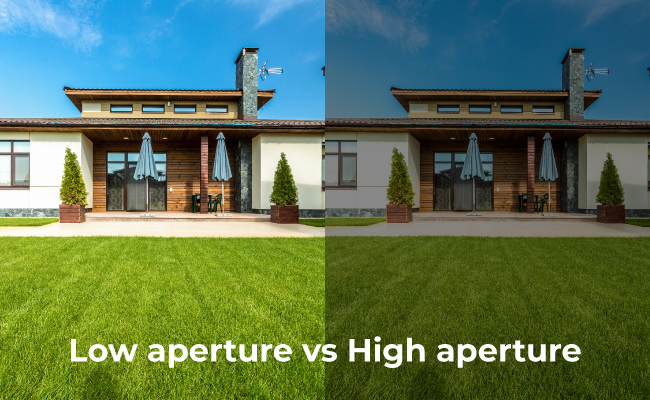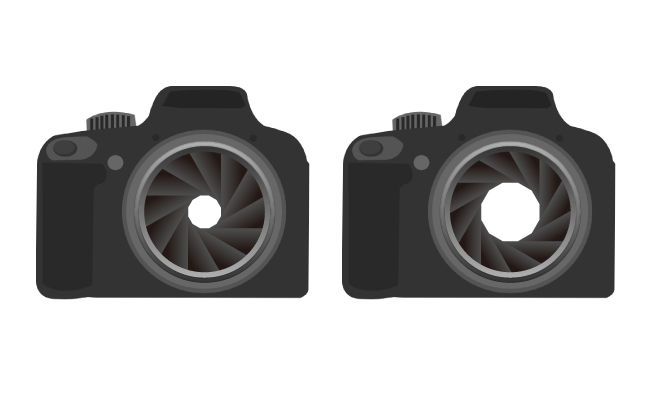Low vs High Aperture: Choosing the Right One for Your Needs

While buying a security or any other camera, you might have noticed or read about aperture. It is an important specification of a camera that decides the final result.
In this article, we will discuss what an aperture is. We will explain what low and high aperture mean. We will compare both in terms of exposure, depth of the field, pros & cons, applications, and other things so that you can pick the right one according to your needs.
- High vs Low Aperture: Basics of Them
- High vs Low Aperture: How Do They Affect Exposure
- High Aperture vs Low: How Do They Affect Depth of Field
- Low Aperture vs High Aperture: Pros and Cons
- Low Aperture vs High: When to Use and How to Choose?
- Bonus: Low Aperture Security Camera Recommendation
- FAQs
- Conclusion
High vs Low Aperture: Basics of Them
What is Aperture?
The aperture is the opening of a camera lens. It could be small or large, and it decides how much light will enter the image sensor. On the specifications, you will notice words like f/1.0 and f/2.8. “f” stands for f-stop, and it is the ratio between the focal length to the aperture’s diameter. It is the way to measure the aperture of a camera.
What is High Aperture?
A high aperture means the camera has a small opening, so it will have a larger f-stop number, such as f/16. Since the opening is very small, it does not allow too much light to enter. It is suitable for well-lit areas.
What is Low Aperture?
A low aperture means a larger opening of the camera lens. It will correspond to a smaller f-stop number, such as f/1.0 or f/2.8. It captures more light and works even in the low-light conditions.

High vs Low Aperture: How Do They Affect Exposure
Exposure means brightness in simple words. When the opening of the camera lens (aperture) changes, it also changes the exposure of the images. That said, you have to control it to get the exact exposure you need.
A low aperture (wider opening) captures more light. It will result in brighter images with more light exposure in the background. It is good for areas where the light is low.
A high aperture (smaller opening) captures less light. That said, the image will appear to be dark. If the background light is too much, this is a good choice.
Keep in mind that aperture is not the only factor to affect exposure. Whether it is high or low aperture, you have to adjust the shutter speed and ISO to get the best results.
High Aperture vs Low: How Do They Affect Depth of Field
Depth of field refers to the zone in a photograph, which is razor sharp. Depending on the aperture you have, you need to capture the object in this zone to ensure excellent quality. If you go out of this zone, the image will lose focus.
A high aperture has a small opening, yet it has a wider depth of field. The range is several meters, which allows you to capture more focused images.
A low aperture has a large opening. More light enters the lens, but the depth of field is shallow. The range is only a few feet. That said, it will be difficult to focus on the object precisely. If the object is within the range, the focus will be on the object, and the background will be blurred.
Low Aperture vs High Aperture: Pros and Cons
Pros and Cons of High Aperture
Pros:
- The depth of field is very wide, which is why it is easier to capture the best shot.
- It offers excellent sharpness and clarity.
- Offers enhanced details and texture. Everything in the background is pretty clear.
Cons:
- Due to the small opening, it receives less light. Therefore, you need proper lighting and perfect - ISO and shutter settings to get the perfect exposure.
- Diffraction can reduce the sharpness of the image.
Pros and Cons of Low Aperture
Pros:
- It focuses on the object more rather than the background.
- Even if the lighting in the background is low, it can work well with the best settings.
- Reduces motion blurs via a faster shutter speed.
Cons:
- The depth of field is too shallow, so it is difficult to get the object in the right range.
- Might blur something important in the background.
Low Aperture vs High: When to Use and How to Choose?
Low Aperture vs High: Applications of Them
A low aperture is an ideal option for portrait photography. Whether it is a wedding or any special event, it can be used. It focuses well on the object instead of the background. You can choose which objects to focus on and which to blur. It can be used in low-light conditions due to larger openings. It offers better exposure.
A high aperture is suitable for landscape and architectural photography. It captures every detail in the background and offers exceptional clarity. It can be used for group photography and capturing the sky at night.
Low Aperture vs High: How to Choose Them?
It depends on where you want to use it and what you want to capture.
For portraits and close-up shots, the ideal option is a low aperture. But if you want to do landscape, group, and architecture photos, go with a high-aperture camera.
In low light conditions, a good option is low aperture. And if there is too might light, go with a high aperture.
Bonus: Low Aperture Security Camera Recommendation
If you need a low-aperture security camera to capture more light, CX810 would be a great choice. It is equipped with Reolink ColorX technology that contains an F1.0 super aperture. It captures four times more light than the F2.0. Therefore, it can work better in low light conditions, and you will get true colors even at night.
It’s an advanced PoE camera that captures in 4K. You get to see every detail with optimal clarity. It also has HDR technology for the perfect hue and rich details. It can automatically detect the person, pet, or vehicle and send instant alerts.
4K PoE ColorX Night Vision Camera
4K Ultra HD with HDR Tech; F1.0 Super Aperture; ColorX True Full Color Night Vision; 3000K Adjustable Warm Light; Advanced 1/1.8'' Sensor
FAQs
1. Is it better to have higher or lower aperture?
It depends on the use case. If you want to focus on the object, go with a low aperture. And for capturing the details in the background, select high aperture.
2. Is f 2.8 high or low aperture?
2.8 is a low aperture. It has a lower f-stop and a larger opening. It can capture more light.
3. Is a 1.6 or 1.8 aperture better?
Both are very close; there is not much difference between them. 1.8 is generally good and works in low-light conditions. It can capture portraits with perfection. But if you want a bit more exposure than that, choose 1.6.
Conclusion
You can’t choose between a low and high aperture unless you know where you want to use the camera. Both are meant for different purposes and suitable for distinct use cases. We have compared both in detail and shared their benefits, pros & cons, and applications. It will help you select the right one without any hassle.
Search
Subscribe for the Latest Updates
Security insights & offers right into your inbox

